BREAKING NEWS
That’s Not My Child: Five generations on the welfare treadmill is now out (Australian Scholarly Publishing/Arcadia, Melbourne, 2024).
Check with your local bookshop – ask them to get one in for you.
The book was launched brilliantly on 16 April 2024 by the Hon Jennifer Coate AO at the Victorian Artists Society in East Melbourne.
This manuscript was previously titled Letters to a Lost Mother (or That’s Not My Child): A family at war
When I last posted about the draft I wrote: “Due to other work (PhD included) and COVID-19 this book, which I have been working on for years, has been further delayed. But the good news is that I have more material and there’s at least one more chapter now to write. Stand by, as they say.”
Synopsis
I seek answers to simple questions that had mystified me for decades. What deep secrets was my mother keeping about my missing grandfather, a World War 1 veteran? Would the answer explain the disappearance of my mother and my baffling childhood in an orphanage many years later? Instead, I discover dark, disturbing events that even my mother didn’t know about.
On her side of the family, more than thirty children spanning five generations were warehoused in children’s institutions in Victoria. It began in 1865 when a vulnerable 11-year old boy was sentenced to five years on Victorian prison hulks. Thus was created a family marked by juvenile detention in gaols and reformatories, debilitating poverty, the birth of children in and out of marriage, the deaths of children in and out of custody, and a soldier-father who used his children to exact revenge for his wife’s unforgivable betrayal.
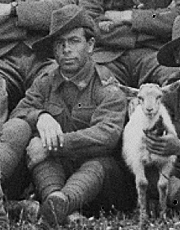
The family struggled against a welfare system determined to cast them as undeserving—and to keep them away from their children. In the form of letters to his mother, I recreate the full astonishing story. It ends with the unexpected intervention of Queen Elizabeth and a world champion sportsman who unwittingly provide a circuit breaker which sends me, at age 15, to the other side of the world, and the long way home to freedom—and back to my extraordinary family.
The book confronts the way the welfare system devalues rather than helps families in crisis. While this story is set in Australia, similar events are now gaining media attention in the UK and Ireland, USA, Canada, Scandinavia and elsewhere.
Photo: Billy Sinnett (my missing grandfather) who returns disillusioned with war only to be confronted by betrayal at home. The soldier-father cannot make peace at home and uses a string of children to exact revenge.
Keywords: 1. Child and family welfare. 2. Children’s institutions. 3. Neglected and criminal children. 4. Industrial School. 5. Reformatory. 6. Orphanage. 7. Ballarat-Victoria-Australia-History. 8. Adoption-Foster care. 9. World War. 10. Genealogy.
HOT OFF THE PRESS Another book that I earlier indicated I was co-authoring with a fellow historian is now at the printers and I expect to post news of its launch in Ballarat in late May . Something of a teaser here
Little-known Children’s Homes in Ballarat
This is an ongoing piece of research into the Homes established in Ballarat by Mrs Elizabeth Nevett. All the information is subject to review (as at January 2019).
These two Homes – well, three if you separate the Laundry from the Cottage of Mercy – are somewhat unusual in the context of the large institutions that existed in Ballarat such as the Ballarat Orphanage, Nazareth House and St Joseph’s Orphanage….read on.
The Bond Street Home
This was a small privately-run, non-denominational Home situated at 56 Bond Street, Golden Point, Ballarat near Llanberris Reserve. From newspaper reports, it opened in 1898.
Mrs Elizabeth Nevett (1849-1944) was the President of a Committee of Management throughout its lifetime. Mrs Nevett, from a well-to-do family, was the wife of a leading Ballarat lawyer. Mr and Mrs Nevett were both prominent in public affairs in Ballarat and, jointly and separately, supported a range of charities. Mrs Nevett was the President of the Ballarat branch of the Australian Women’s National League (AWNL).[1]
Records of the Bond Street Home cannot be located at this time. It is possible that no official records were kept – or if they were, they were not archived when the Home closed in 1925. For information about the Home we have to rely on the occasional reports in the local press – Ballarat Courier and Ballarat Times. Thank goodness for the wonderful research tool called Trove.
It is not clear why the Bond Street Home was set up when a large Orphanage was already in existence in Ballarat East – not to mention the equally large Nazareth House (a Catholic orphanage opened in 1888) and the Canadian Rescue and Children’s Home (a small Home run by the Town & City Mission from 1897).
The boarding-out policy that allowed children to be placed in foster homes (sometimes with their own mothers) was an alternative in Ballarat (See e.g. Ballarat Star 25.12.1914, p. 11).
Mrs Nevett was not enamoured of the boarding-out system partly because she saw it as a commercial arrangement that allowed mothers to shirk their responsibility. Further, she considered a small Home like Bond Street offered a more homely atmosphere with assured values – a ‘real home life’ that paid foster mothers could not match (Ballarat Star, 12.12.1914, p. 2).
The relationship with the Orphanage was ambivalent. Appealing to members to donate to the Bond Street Children’s Home in 1899, the Chairman of the Ballarat Stock Exchange, JD Woolcott, felt it necessary to stress that ‘the institution in no way clashed with the Orphanage’. He pointed out that the Home frequently took in ‘little ones whose parents were living, but whose surroundings were such that it was to the interest of society that they should be rescued from them (Ballarat Star 21.2.1899, p. 2).
Yet, there were obvious tensions between this small institution (never more than 15 children at a time) and the large Orphanage (which at its peak had 230 children). When presenting the Annual Report of the Children’s Home for 1913, Mrs Nevett stated that ‘the government had withdrawn the small grant they gave us for many years, because we refused to amalgamate with the Orphanage’ (Ballarat Star 26.8.1913, p. 2). The basis of this refusal is not stated.
It is interesting to note that Elizabeth Nevett’s husband was never a member of the Board of Management of the Orphanage when men of his prominence in Ballarat’s civic affairs were enthusiastic to play that role. (Women could join a Ladies Committee, but Mrs Nevett never did join.) Despite considerable publicity given to financial donors, the Nevetts made no substantial contribution to the Orphanage – the legal firm of Nevett & Nevett contributed its first token guinea in 1909 – and that was their standard annual donation thereafter.
It is possible to hypothesise that Mrs Nevett founded the Children’s Home as her personal project – one she could govern and control without interference. She was the driving force: she
- raised funds and marshalled in-kind support,
- selected its staff,
- signed off on every annual report, and
- was the public voice of the Home in the local press.
She was a devout Christian and brought the values of the Mothers’ Union of Ballarat (she was its Secretary in the 1890s) to her ‘rescue’ work with children. In 1909, Mrs Nevett was Gazetted as a Probation Officer for the Neglected Children’s Department (Victorian Government Gazette 3.11.1909, p. 4810).
Mrs Nevett reported that Mrs Simpson, Matron for ten years, who retired in 1913, had served the Home since the children had been infants. And the children were
‘now getting to the age of usefulness, and desire to develop their garden and make it productive…’
This suggests that a proportion of the children had been long-term residents (Ballarat Star 26.8.1913, p. 2). Mrs Crowe took over as Matron from Mrs Simpson in 1913 and was much praised: Mr Hauser, the Principal of the local Mt Pleasant Primary School, reported that the children were clean and well dressed and attended school regularly (Ballarat Star, 7.11.1914, p. 11)
The War which began in 1914 created competing priorities for Mrs Nevett and the middle-class women who had previously volunteered their efforts on behalf of the Home. The Annual Meeting was delayed by seven months in 1915 and again in 1917 ‘because of the pressure of other work’, notably patriotic work that ‘overshadowed the small local charities’. At the same time, the Home was beginning to experience financial stress (Ballarat Star 10.3.1916, p. 4; 7.3.1918, p. 2)
Mrs Allen replaced Mrs Crowe as Matron in 1916 but the numbers of children slowly dwindled – by 1920 there were just seven including two boys working at the local woollen mill. Perhaps the boarding-out scheme was having an impact. In Ballarat in 1920, the local Inspector of the Neglected Children’s Department visited 538 boarded-out children in foster homes or in their own homes between August and October alone (Ballarat Star, 25.12.1920, p. 7)
Towards the end of 1922, Mrs Nevett decided she and her lady friends were not now able to continue its operations. It was time to close the Home. Mrs Nevett, through her husband’s legal agents, asked the Supreme Court for a ruling on the distribution of assets –
- two blocks of land, valued at about £1 000 on one of which the home was built, and
- money on current account amounting to £104.
It was noted that the Ballarat Town and City Mission carried on similar work in Ballarat and was willing to receive the assets and apply them to similar work. The Court so ruled, providing that the sum of £100 be gifted to the Free Kindergarten. The Ballarat Star (10.2.1923) reported that 56 Bond Street was up for auction.
♣♣♣
The Children’s Home Laundry and Cottage of Mercy
This other institution was closely linked to the Children’s Home. It was set up by Mrs Nevett in 1898 or 1899 initially in a house on the corner of Dana and Raglan Streets, Ballarat.
The object of the institution was
‘to assist women upon whom society frowns to earn a living, and…prevent the necessity for boarding out children of shame.’ (Ballarat Star 31.3.1899, p. 2).
The ultimate goal was to train the ‘children of shame’ to earn their own living. The sparsely furnished laundry was managed by a small committee of women, but Mrs Nevett made a successful appeal for furniture, blankets and bedclothes, and cast-off clothing. ‘God’s work must prosper,’ was her keynote (Ballarat Star, 5.8.1903, p. 4).
In 1903, the Children’s Laundry moved to ‘Marlborough House’, in Victoria Street, Ballarat while the Cottage of Mercy moved to ‘Melrose’, in Eyre Street near the Benevolent Asylum. A Mrs Clennel (a former Salvation Army Officer) was in charge of the laundry and a Mrs Simpson was Matron of the Cottage of Mercy (although there is some confusion about whether Mrs Simpson was also Matron of the co-existing Bond Street Children’s Home).
An observer reported:
‘…it is not that children do the laundry work, but that the mothers do the work and the little ones do the looking on.’
The women in question, he reported, were those
‘not admissible to the Maternity Home…poor lasses who have been too trusting, and allowed themselves to be led astray…’
There were about a dozen ‘girls’ and their babies in residence at that time but over the previous five years some 50 ‘young girls and babies had been looked after and cared for’ (Ballarat Star 6.2.1903, p. 3).
In 1908 Mrs Nevett was compelled publicly to deny reports that the ‘girls’ were not allowed religious freedom. The Home was ‘strictly unsectarian’, and the residents could attend any church of their choice. She, herself, had given simple religious instruction,
‘the sole object being to try to awaken them to the knowledge of the All Father, the God of love, and to try and induce them to live higher and better lives…’ (Ballarat Star 23.11.1908, p.4)
The following year, Mrs Nevett would have been pleased with the unanimity of a public meeting on juvenile morality in Ballarat – in particular, neglectful parents allowing young girls on the streets at night and being thus placed in danger of ‘acts of brutality and immorality’. It was Mr Nevett who successfully moved for the formation of a council of 36 clergy and laymen (no women) to implement the range of resolutions carried at the meeting (Ballarat Star 17.2.1909 p. 1).
In 1910, Mrs Nevett reported that the government was
‘withholding State aid… because our Homes receive so little local support’.
She thought this ‘most unjust’ because they were amply supported by volunteers and in-kind support. Nevertheless, she was determined to push on. She had even purchased a block of land in Lydiard Street north where she intended to build the training laundry. Meanwhile, she reported, the Bond Street Home was free of debt (Ballarat Star 15.10.1910, p. 4).
However, all was not smooth sailing. In 1914, Mrs Nevett informed the public that the laundry was closing. She argued that
‘young women prefer to board out their infants, and are encouraged to do so by the State…’
And because the State had ‘become the foster mother’ relieving parents of all responsibility, maternity homes were no longer necessary. Tellingly, she went on to claim that the Wages Board was also making it impossible to make a profit from the laundry. She did not refer to the competition from the established laundry run by the Town and City Mission where ‘worthy women’ who had been paid a wage – although it too fell on hard times and was sold off in 1914 (Ballarat Star 14.7.1914, p. 3)
In lieu of a laundry, Mrs Nevett revealed her new plan for the Lydiard Street block: she would build a training home for children. Collectively, there were 13 children in the Bond Street Home and the Cottage Home (Ballarat Star 4.11.1911, p. 3). That goal was never achieved.
On 29 November 1944, Elizabeth Nevett (nee Dowling) passed away at her home in Ballarat, aged 93, living not quite long enough to see her beloved AWNL merge with the Liberal Party of Australia. But she may well have listened to the radio talk by the Party’s leader, Robert Menzies, in 1942:
…to say that the industrious and intelligent son of self-sacrificing and saving and forward-looking parents has the same social deserts and even material needs as the dull offspring of stupid and improvident parents is absurd.[2]
Having assisted ‘women upon whom society frowned’ and provided a Home to their ‘children of shame’, Mrs Nevett perhaps would not have fully agreed with Menzies’ sentiment.
Footnotes
[1]The Australian Women’s Register reports: ‘The Australian Women’s National League (AWNL) was a conservative women’s organisation established in 1904 to support the monarchy and empire, to combat socialism, educate women in politics and safeguard the interests of the home, women and children. It aimed to garner the votes of newly enfranchised women for non-Labor political groups espousing free trade and anti-socialist sentiments, with considerable organisational success.’ (http://trove.nla.gov.au/people/598652?c=people)
[2] Robert Menzies, ‘The Forgotten People’, Speech broadcast on 22 May 1942, reprinted in Sally Warhaft (ed.) 2004 Well May We Say…The Speeches that Made Australia, Melbourne, Black Inc: 155.
SOLD OUT. An Orphan’s Escape: Memories of a lost childhood. Lothian Books, Melbourne, 2005. More information, including reviews, here.
OTHER BOOKS
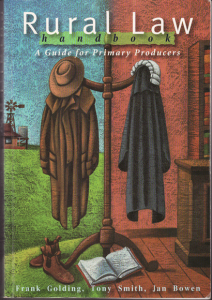 Rural Law Handbook, With Tony Smith and Jan Bowen. Victoria Law Foundation, Melbourne, 2002, A best-seller now adapted as an online service.
With Sharon Guy, The Re-Discovery of the Ballarat Orphanage’s Arthur Kenny Avenue: Commemorative Booklet, Ballarat Child & Family Services, 2012. CAFS in Ballarat has issued an updated version taking into account that the Avenue was relocated to Fortune Street in 2015.
Rural Law Handbook, With Tony Smith and Jan Bowen. Victoria Law Foundation, Melbourne, 2002, A best-seller now adapted as an online service.
With Sharon Guy, The Re-Discovery of the Ballarat Orphanage’s Arthur Kenny Avenue: Commemorative Booklet, Ballarat Child & Family Services, 2012. CAFS in Ballarat has issued an updated version taking into account that the Avenue was relocated to Fortune Street in 2015.
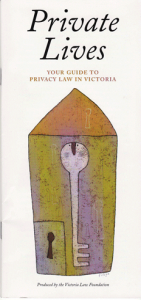 Private Lives: Your guide to privacy law in Victoria. Victoria Law Foundation, Melbourne, 2003. A quick guide to Victorian and Commonwealth privacy laws.
Body Corporate: a quick guide to the law in Victoria. Victoria Law Foundation, 2005. An earlier version previously published as Common Ground: Your guide to body corporate law and living, Victoria Law Foundation, Melbourne, 2002.
Private Lives: Your guide to privacy law in Victoria. Victoria Law Foundation, Melbourne, 2003. A quick guide to Victorian and Commonwealth privacy laws.
Body Corporate: a quick guide to the law in Victoria. Victoria Law Foundation, 2005. An earlier version previously published as Common Ground: Your guide to body corporate law and living, Victoria Law Foundation, Melbourne, 2002.
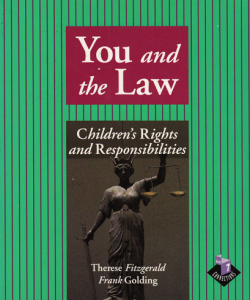
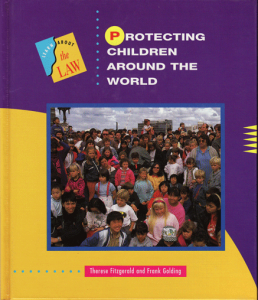 You and the Law: Children’s rights and responsibilities. With Therese Fitzgerald. Melbourne, MacMillan, 1994. Republished as How Laws Protect You, MacMillan, 1996.
Children and Laws around the World. With Therese Fitzgerald. Melbourne, MacMillan, 1994. Republished as Protecting Children Around the World, MacMillan, 1996.
Compendium of Good Practice: The role of schools in the vocational preparation of Australia’s senior secondary students. NBEET, AGPS 1995. How schools and TAFE institutions coordinate vocational programs.
You and the Law: Children’s rights and responsibilities. With Therese Fitzgerald. Melbourne, MacMillan, 1994. Republished as How Laws Protect You, MacMillan, 1996.
Children and Laws around the World. With Therese Fitzgerald. Melbourne, MacMillan, 1994. Republished as Protecting Children Around the World, MacMillan, 1996.
Compendium of Good Practice: The role of schools in the vocational preparation of Australia’s senior secondary students. NBEET, AGPS 1995. How schools and TAFE institutions coordinate vocational programs.
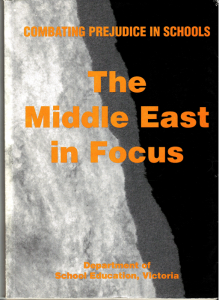
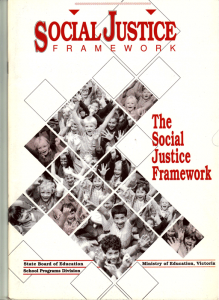 The Middle East in Focus: Combating prejudice in schools. With Cavell Zangalis, Jillian Wright and Celia Meehan. Melbourne, DSE, 1992. A rapid response to racial prejudice in the wake of the first Gulf War.
The Social Justice Framework. With Helen Praetz and Andrew Sturman. Melbourne, State Board of Education and Office of Schools Administration 1991. An elegant conceptual map for navigating social justice in schools.
The Middle East in Focus: Combating prejudice in schools. With Cavell Zangalis, Jillian Wright and Celia Meehan. Melbourne, DSE, 1992. A rapid response to racial prejudice in the wake of the first Gulf War.
The Social Justice Framework. With Helen Praetz and Andrew Sturman. Melbourne, State Board of Education and Office of Schools Administration 1991. An elegant conceptual map for navigating social justice in schools.
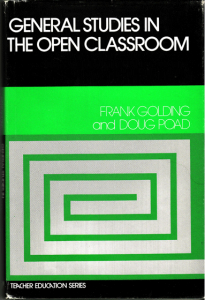 Polycom Sampler: Readings in the development of education in and for, a multicultural society. As compiler/editor. Ministry of Education, Melbourne, 1988. A compilation of the ’best’ articles from Polycom over more than a decade.
General Studies in the Open Classroom. With Doug Poad. Sydney, Angus and Robertson, 1973. A book in the Teacher Education Series.
Polycom Sampler: Readings in the development of education in and for, a multicultural society. As compiler/editor. Ministry of Education, Melbourne, 1988. A compilation of the ’best’ articles from Polycom over more than a decade.
General Studies in the Open Classroom. With Doug Poad. Sydney, Angus and Robertson, 1973. A book in the Teacher Education Series.
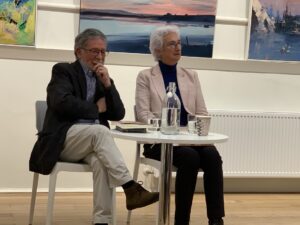


One thought on “Books”
Comments are closed.